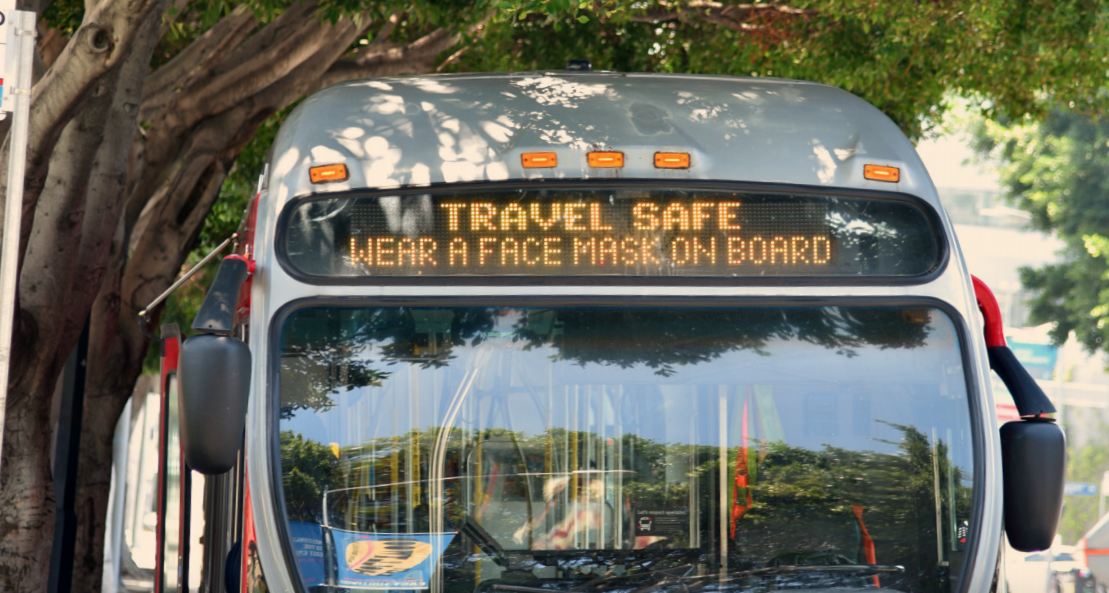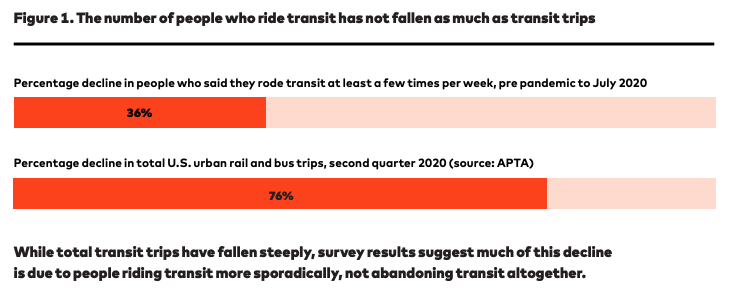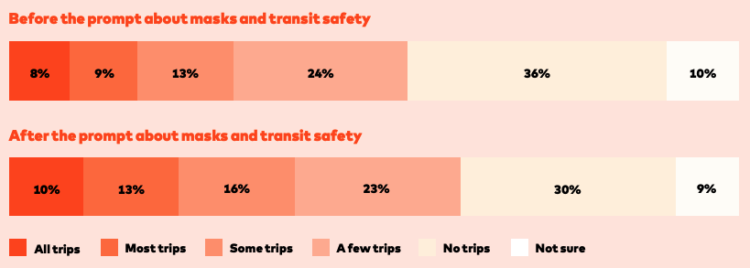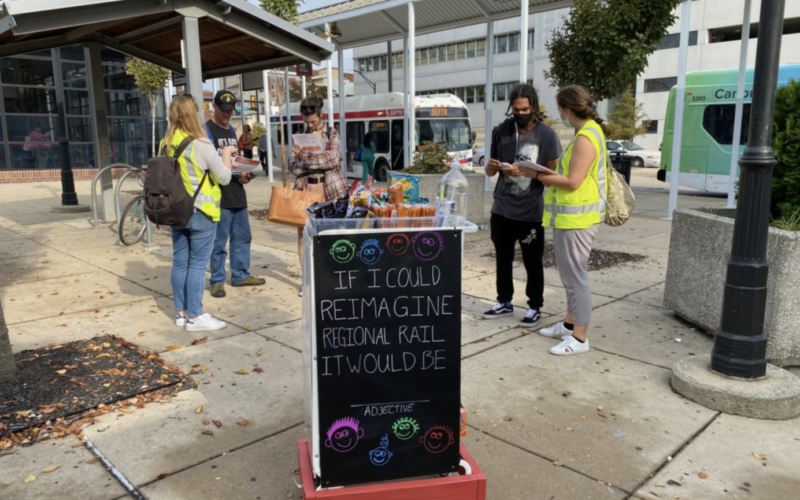
Photo: LA Metro
The COVID-19 pandemic is a perilous moment for transit. The health and wellbeing of transit riders and transit workers are at risk, and people are wary of riding in shared vehicles. In a new report, TransitCenter provides a roadmap for policy makers to navigate this crisis, safeguard transit workers and transit riders, and prepare transit to serve a critical role in the recovery.
The report, “A Transit Agenda for the COVID-19 Emergency,” includes new public opinion research from focus groups and a survey of more than 2,000 U.S. residents in urbanized areas.
The survey sheds light on how transit travel behavior has changed during the COVID crisis, and how people view transit in the midst of the pandemic. Many people continue to ride transit — some more often than others. Riders want assurance their trips will be safe and reliable. By taking steps to reduce risk on transit and make service effective for people who are riding now, transit agencies and city governments will secure immediate safety gains while making strides toward long-term improvements in transit access, equity, and quality.
Main findings from the survey and focus groups
- Many people are riding less but not abandoning transit. Overall transit ridership declined about 75% in the second quarter of 2020, but the number of people who ride transit has not fallen so steeply, according to our polling. Among survey respondents, the share of people who say they ride transit at least a few times per week fell much less — 36%. This suggests that many people who formerly rode transit multiple times per day may now be riding sporadically, not avoiding transit altogether. In focus groups, many riders said they would return to regular transit usage when the pandemic recedes.

- Collective mask-compliance makes transit safer — and makes people more comfortable riding transit. In cities where viral transmission is low, like Seoul and Taipei, millions of people safely ride transit every day thanks to high rates of mask compliance. When informed of the importance of collective mask-wearing for transit safety, the share of survey respondents who said they planned to ride transit rose from 54% to 62%.

- Riders expect to make fewer trips during traditional morning and evening rush hours, and more trips during “off-peak” hours. Standard transit agency practice concentrates service frequency during peak hours. But since many essential workers do not work 9 to 5 shifts, peak-oriented schedules align poorly with transit trip patterns during the pandemic. The survey results suggest agencies should prepare for a sustained shift to greater off-peak ridership, providing consistent frequency throughout the day.

Download the YouGov survey results and focus group summary.
Main policy recommendations
- Protect transit workers and transit riders. With strong sick leave and quarantine policies, transit agencies can enable workers to make the safe choice to stay home instead of risking further spread. Strong guidance and communication on mask wearing, including the provision of masks for riders who may lack them, help attain the high rates of compliance that collectively protects riders. And keeping vehicles and stations well-ventilated circulates fresh air, protecting riders and workers from viral exposure.
- Safe and equitable service provision. During the pandemic, transit routes that serve primarily Black and brown neighborhoods have retained more ridership. The MBTA in Boston, Muni in San Francisco, and other transit agencies have demonstrated how to adapt service for these new travel patterns, enabling riders to make essential trips while preventing crowding on board.
- Quickly prioritize transit on the street. Car traffic is rising fast as cities reopen. At the same time, bus service has retained a greater share of ridership than other modes of transit, perhaps reflecting that essential workers are more likely to travel by bus. Without a network of transit-priority lanes in place, traffic congestion threatens to overwhelm bus service, making trips even slower and less reliable than before the onset of COVID-19.
- Boarding procedure and fare policy. During periods of elevated risk, agencies have suspended fare collection on buses, shifting boarding to the rear door. This eliminates potential contact during fare transactions and generates space between the bus operator and the passenger area. Agencies should only resume bus fare collection when case rates are low enough that the virus can be contained and suppressed with test-and-trace methods. For agencies with the resources to do so, shifting to contactless fare payment with all-door boarding can provide long-term benefits for safety and bus performance.
- Demand management. To spread trips throughout the day and avoid rush hour crowding, cities can encourage employers to stagger commute times and offer incentives for employees to ride transit instead of drive. Good information is also a form of transportation demand management: If riders know that the bus or train that’s arriving at 7:30 AM is crowded, they might choose to travel on a less crowded one at 7:45 AM, if their schedule is flexible.
Transit will face stiff headwinds as the U.S. endures the pandemic and, in time, emerges from it. If policy makers do not rise to meet these challenges, urban transportation systems — and the cities they support — will break down. Automotive traffic will overwhelm city streets, jobs will be further out of reach for vulnerable residents, air quality will worsen, and health disparities along lines of race and class will grow wider.
This scenario is entirely avoidable if policy makers respond with urgency. Through decisive action, they can provide transit riders with better service than before the pandemic struck. Better transit service will make possible broadly-shared prosperity, and combat the inequities in public health and economic status that the pandemic exposed. People who rely on transit enabled cities to withstand the lowest point of the COVID-19 crisis. Now, to recover from this emergency, city leaders must enable people to travel safely and conveniently on transit.
 New TransitCenter Report: To Solve Workforce Challenges Once and For All, Transit Agencies Must Put People First
New TransitCenter Report: To Solve Workforce Challenges Once and For All, Transit Agencies Must Put People First
TransitCenter’s new report, “People First” examines the current challenges facing public sector human resources that limit hiring and retention, and outlines potential solutions to rethink this critical agency function.
Read More A Transit Revolution in Philadelphia?
A Transit Revolution in Philadelphia?
The Southeastern Pennsylvania Transportation Authority (SEPTA) has been working throughout the pandemic on several system-wide planning initiatives that have the potential to transform transit service in and around the city of Philadelphia.
Read More